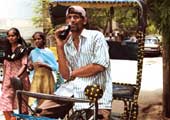
The
Rs 47,800-crore fast moving consumer goods (FMCG) industry, comprising
essentially the market for packaged branded consumables, grew by
just 1.4 per cent in 2003. And key products such as packaged tea,
detergent cakes & bars, even toothpastes registered a negative
growth rate. Nothing-not the advent of regional brands, or downtrading
by consumers, or the near-saturation levels in products such as
toilet soaps-really convincingly explained why FMCGs had to suffer,
while most other consumer categories such as mobiles phones, durables,
autos and services boomed.
"Marketers were either looking at the
traditional four regions or were going state-wise, and either way
they could come up with little in the way of explaining market behaviour,"
says Subhashree Chalil, Senior Manager, ACNielsen, and the author
of Different Strokes For Different Folks, the path-breaking study
that puts forth the case for breaking up the country into seven
regions-North, North Central, West, South, South Central, East and
East Central-from the marketing point of view to obtain new, meaningful
insights into current consumption levels and potential for growth.
Using geographical contiguity along with socio-economic
and cultural parameters in the study of affordability, market accessibility
and consumption disposition, ACNielsen mapped these seven regions
and then overlaid them with broader demographics and FMCG retail
sales figures. What emerged was a new way of looking at the market,
one that offered new insights into consumption patterns and market
clusters. "The four regions-North, South, East and West-that
most marketers tend to look at are too broad for any meaningful
interpretation of FMCG performance," says Jayasurya Chemudupati
of ACNielsen, the author of Divine Diversity, a follow-up paper
on this new regionalisation.
But didn't many FMCG marketers already follow
some sort of sub-regional classification? "We have 15 marketing
areas in the country, which are largely divided on the basis of
geography," says Jayashree Mohanka, Group General Manager (Marketing),
Eveready Industries. And most other companies that BT spoke to-Coca-Cola
India, Hindustan Lever, Procter & Gamble, ITC, Gujarat Cooperative
Milk Marketing Federation (GCMMF), Henkel Spic, Agro Tech Foods,
Godrej, Dabur, Marico and Emami-will tell you that based on their
specific product category needs, they do work on sub-regional sales
and marketing structures.
Coca-Cola India slices Andhra Pradesh into
a separate region, apart from the regular segments, North, South,
East and West, primarily because it is one of the highest selling
states for carbonated soft drinks. GCMMF historically works on a
six-zone structure, and treats Maharashtra & Goa separate from
the West, because it is headquartered in Anand, Gujarat, and West
for it means the closer markets of Gujarat, Rajasthan, Madhya Pradesh
and Chhattisgarh. "As far as infrastructure is concerned, we
follow the five-zone strategy, with two zones in the West. For marketing
purposes, the break-up differs depending upon the product in question,
with no homogenous model as such," says Ashish Bhargav, Marketing
Manager, Marico. Increasingly, marketers are voicing the need for
a sharper regional segmentation. "A move is underway (at Emami)
to sub-divide Uttar Pradesh into three sub-zones. But no final decision
has been taken yet," says Harsh Agarwal, Director, Emami Group.
So, what's really new with this seven-region
model? Lots actually. For one, it gives FMCG marketers a view of
contiguous market clusters at a broad regional level sans artificial
distortions in tax-related state boundaries, historical sales organisation
or wholesale and retail structures. It clubs markets on the basis
of economic and developmental parameters, and not purely on geography.
So Madhya Pradesh is not West or Central, as most marketers have
hitherto tended to classify it, but North Central along with Uttar
Pradesh and Rajasthan.
How does that help marketers? The traditional
four-region model clubs a market like Madhya Pradesh in the North,
bringing down not just the average for the more prosperous Punjab,
Haryana and the National Capital Region (NCR), but erroneously showing
it in a more positive light even though its consumer parameters
such as low per capita income, small pack size, large family size,
low urbanisation levels and preference for economy products place
it on a level with states such as Uttar Pradesh and Rajasthan. "Marketers
can now pick up new cues on products, pricing and retail, and more
sharply identify saturated and underdeveloped markets," adds
ACNielsen's Chalil. Almost all FMCG marketers desperately need to
do this to shore up their slipping sales, and of late, even profits.
Will this new regionalisation help rescue them from the current
growth guillotine? That'll be interesting to watch.
NORTH
More Volumes Please
 |
| Big is best: High per capita income coupled
with large family size make North a volume driven market, even
for promotions |
Large average household
size (read joint-families) coupled with higher levels of affordability
make big pack sizes a favourite across most FMCG categories such
as edible oil, tea and atta in the North. Volume-led promotions,
the ones that offer extra volume at the same price, are most popular.
The consumer mostly patronises the local grocer (such establishments
account for 66 per cent of all fmcg sales).
The Green Revolution-led prosperity in Punjab-this
is tapering-off from its 1980 highs-and the presence of the NCR
in the North make it the country's most urbanised region (43 per
cent urban population), with the highest per capita annual FMCG
consumption, at Rs 871, across all seven regions. And even while
the region is saturated for product categories such as tea, refined
oil, shampoo, skin creams and toilet soaps, a host of other categories
like coffee, coconut oils, beverages and tooth powders-per capita
consumption is lower than the national average-have huge potential
for growth. Even expensive lifestyle products, like hair dyes, sell
like hot cakes here.
 |
| Strength in numbers: North Central's
huge semi-urban, low-income population makes it a 'sachet' FMCG
market |
NORTH CENTRAL
The Big, Small Market
With urbanisation
at a mere 22 per cent, consumers here spend just Rs 364 a year on
FMCGs. Yet its 312 million-strong population, the highest across
all regions, makes North Central the biggest FMCG mart in the country,
accounting for almost a quarter of the Rs 47,800-crore market. And
surprisingly, even though mass FMCG categories such as soaps and
detergents have all stagnated here, lifestyle products like skin
creams have recorded a phenomenal 9 per cent plus growth rate right
from 1999 to 2003, though on a very small base.
Much like the case of its rich neighbour in
the North, volume promotions are a hit in North Central. However,
low per capita income and growth hinder sales of big pack sizes.
Therefore, there is a higher preference for economy products and
lower unit packs (read small packs). Traditional grocers reign supreme
in the retail environment. Washing powders, detergent cakes, shampoos,
blades and namkeens, are the categories to watch out for in this
region.
WEST
Money For Time, Convenience
 |
| Ready-to-eat: Convenience and high urbanisation
make West an ideal market for processed foods and non-grocery
retailers |
Highly developed
infrastructure, high per capita income, high urbanisation levels
and small average household size-all factors aiding FMCG consumption-make
West the second biggest FMCG market after North Central in the country.
So why has per capita non-food FMCG consumption fallen, from Rs
318 in 1999 to Rs 299 in 2003? Well, blame it on the influx of low-income
migrants who have thronged the country's commercial capital, Mumbai.
And even though West mirrors North's preference
for big pack sizes, the basket here is for entirely different product
categories: think, for instance, scourers, fabric care and cooking
medium. Processed items account for almost 70 per cent of the consumer's
food purchases, with the convenience of packaging catching on even
in basic provisions like cooking mediums and rice. And even though
the grocer remains strong, chemists and non-traditional outlets
are fast gaining currency for buying a soap bar or a tube of toothpaste.
SOUTH
Small Is Big
With the second
highest per capita FMCG consumption (after North), at Rs 651 per
annum, and a high per capita income, the South is turning out to
be a lucrative market for washing powders, skin creams, anti-septic
creams, butter, ketchup and sauces. Growth in services coupled with
non-resident remittances and a very high literacy rate is propelling
this region as FMCGs' growth engine for the future, with growth
rates hovering above 6 per cent during 1999 to 2003.
Growth in expensive lifestyle products such
as hair dyes, sanitary napkins and acne preparations have skyrocketed
in the South, at 12.9 per cent, substantially higher than the mass
FMCG products (soap, toothpastes), which grew at 5.3 per cent between
1999 and 2003. With a small family size, South remains typically
a small-pack market and perhaps the only region where a fifth of
all FMCGs get dispensed through chemist shops.
SOUTH CENTRAL
Marketer's Delight
 |
| A perfect mix: Traditional grocers get
perfectly with South Central's tech boom-led growth in lifestyle
and food FMCGs |
Though, politically,
the jury is still out on whether economic reforms implemented by
the ousted Telugu Desam in Andhra Pradesh and the Congress in Karnataka
had any significant trickle-down effect or not, South Central has
remained a delight for FMCG marketers, logging the highest growth
rate at 7.6 per cent between 1999 and 2003.
Spends on food FMCGs grew 9.1 per cent, and
this when seen in the context of a high 75 per cent share of processed
foods in the consumer's food basket, makes South Central a growth
market for all kinds of packaged foods, ranging from cheese to ketchup
to sauces. And unlike the South, grocers still remain a very dominant
retail medium for FMCGs in South Central, accounting for nearly
64 per cent of all sales. Skin creams and mosquito repellents are
the two categories where consumers tend to spend the most, one reflecting
the region's high per capita income and aspirations build-up by
the tech boom, and the other, well, what else, but the failure of
governance.
 |
| Betting on brands: Despite East's low
per capita income and poor infrastructure, the consumption attitude
is already there |
EAST
Proof Of The Pudding
East is a region
with low urbanisation (24 per cent), medium-to-low per capita income
and a far-from-optimal infrastructure. With only high literacy as
a positive beacon, the region surprisingly mirrors the more prosperous
South and South Central in its consumption behaviour.
There has been a shift from economy to premium-priced
products in the East, though affordability dictates choice of low-priced
packs. And increasingly, consumers here are getting brand conscious,
preferring MNC brands to Indian ones, much like their counterparts
in South and South Central. With 12 per cent of the country's population,
and FMCG contribution lagging at 11 per cent, the region holds huge
promise for liquid toilet soaps, shampoos, sanitary napkins, biscuits,
even chocolates.
EAST CENTRAL
Half-empty or Half-full?
 |
| Promised land?: If UPA's much touted
agricultural investments and guaranteed employment kikcks in,
East Central will rev up |
The most impoverished
region in the country, with low per capita income, low literacy
and very poor infrastructure, consumers here barely spend Rs 293
per annum per head on FMCGs. And small packs rule the market (52
per cent of all FMCG sales), with affordability being a major purchase
criteria.
What's heartening for marketers, though, is
the region's high growth rate, 4.5 per cent in 1999-2003, just below
South Central and South. And what's important is that this cuts
across both food and non-food FMCGs. So even though it trails national
FMCG consumption (9 per cent to its 14 per cent population), categories
like baby massage oils, weaning foods, acne creams, hair dyes and
phenyl hold promise.
-additional reporting by Arnab
Mitra, Nitya Varadarajan and Priyanka Sangani
|
